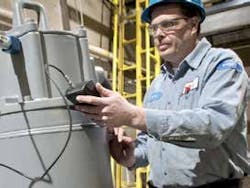Flygt N-pumps in Vancouver, WA
This article appeared in the October 2012 issue of Water and Waste Digest.
Located across the Columbia River from Portland, Oregon, the City of Vancouver Washington has distinguished itself as a leader in effective sanitary sewer system management by maintaining adequate capacity, proactively maintaining sewage infrastructure, and minimizing the cost for existing and new ratepayers.
Project or Scope
Like many municipal wastewater utilities elsewhere, some increasingly popular consumer products have proven problematic for elements of Vancouver’s infrastructure. For the crews that maintain the wastewater collection system of Vancouver, however, a particularly popular consumer product—household cleaning and personal wipes—emerged as a costly and paralyzing problem at a strategic lift station in 2004.
“Just because a product is disposable doesn’t mean it’s flushable.”
Built in 2000, the Andresen Pump Station is the largest lift station in the Vancouver system. The Andresen facility brought on line a 3500 gpm low-head facility with a predominantly commercial and residential flow from a gravity line. The low-head station pumps the wastewater into an immediately adjacent high-head, 4400 gpm pump station equipped with four 300 hp pumps. From there, the combined wastewater from another gravity facility and direct flow into the high-head station are pushed through a force main over a hill with a 130-ft. elevation before advancing to one of the WWTPs.
“When the pump station came online just before 2004, we noted routine maintenance incidents involving clogged pumps. As the years passed, the clogging and maintenance increased to a frequency of twice and sometimes three times per week,” recalls Frank Dick, PE, an engineer with Vancouver’s Public Works.
“It became apparent there was a direct correlation between household cleaning and personal wipes and the ragging that steadily sapped the flow and efficiency of the pumps. The increased incidences of clogging at the low-head lift station averaged three unscheduled maintenance dispatches a week. To clear the entangled impeller of a 40 hp pump at the low-head facility normally took two hours by an outsourced crew at a rate of $80 per hour.“
Solution
The City’s engineering staff received a recommendation for the Flygt “N-pump” to prevent clogging in the low-head Andresen station. In field tests where recurring blockages were an issue in wastewater collection utilities, the pumps not only eliminated clogging but also delivered significant power savings that would accrue throughout the expected service life period of more than 50 years.
The reliability of an N-pump can be attributed to the semi-open, screw-shaped impeller that prevents clogging and facilitates the unobstructed flow of fibrous material. Without material wrapping around the impeller and sapping pump flow and efficiency, energy savings often exceeded 45% during field tests due to the patented component. The leading edge of the pump’s rotating impeller passes across a stationary relief groove located in the pump suction port. The dynamic action cleans and pumps away any rags, stringy materials and solids from the impeller without compromising the hydraulic efficiency.
“The engineering is more reliable than traditional chopper pumps that can grind rags and other debris.”
Result
The city approved the expenditure for the cost to replace the original pumps with Flygt N-pumps after Dick presented an electricity cost savings analysis and two-inch thick file of work orders for unscheduled maintenance at the low-head station. “Each page represented a $160 expenditure,” he said. By eliminating unscheduled maintenance, the utility stood to save at least $20,000 annually by replacing the original pumps with the highly reliable N-pump units. Electric utility reductions—proven at least 45 percent by the metering period—will further add to the total savings over the life of the equipment.
Additionally, the original two low-head 25 hp Flygt units continued to run without ragging and never exceeded a 32 amp draw for more than a year before receiving their routine maintenance inspections.
Editor's Note: Scranton Gillette Communications and the SGC Water Group are not liable for the accuracy, efficacy and validity of the claims made in this piece. The views expressed in this content do not reflect the position of the editorial teams of Water & Wastes Digest, Water Quality Products and Storm Water Solutions.

